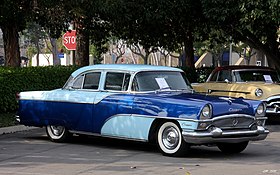Packard Clipper
| Packard Clipper Clipper (1956 only) |
|
|---|---|

1955 Packard Clipper Custom 4-door Sedan
|
|
| Overview | |
| Production | 1941 to 1942 1946 to 1947 1953 to 1955 1956 (Clipper marque) 1957 |
| Body and chassis | |
| Related |
Packard Executive Packard Panther |
| Chronology | |
| Predecessor | Packard 200 |
The Packard Clipper is an automobile which was built by the Packard Motor Car Company (and by the later Studebaker-Packard Corporation) for models years 1941 to 1942, 1946 to 1947 and 1953 to 1957. For 1956 only, Clipper was classified as a stand-alone marque. The Clipper was introduced in April, 1941, as a mid-model year entry. It was available only as a four-door sedan. The Clipper name was reintroduced in 1953 for the automaker's lowest-priced lineup. By 1955, the Clipper models were seen as diluting Packard's marketing as a luxury automobile marque. It was named for a type of sailing ship, called a clipper.
For only the 1956 model year, the Clipper became a stand-alone make of automobile produced by the Studebaker-Packard Corporation. The Clipper lineup was aimed at the middle-price field of American automobiles that included DeSoto, Oldsmobile, and Mercury. Following the closure of Packard's Detroit, Michigan factory in 1956, the Clipper marque was discontinued, although the Clipper name was applied to 1957 Packards that were built at Studebaker's South Bend, Indiana factory.
By the end of the 1930s, Packard president Max M. Gilman realized that his best efforts to improve profitability during the last lean decade had not been enough. The Packard One-Twenty had arrived in 1935 and saved the company from immediate demise; the One-Ten had followed, achieving even higher volume. But despite a strong performance in revival year 1937, Packard sales had plummeted as the depression returned in 1938, and the 76,000 sales for the calendar year 1939 were hardly past the break-even point. To be precise, they netted the company a scant half million dollars. This precarious financial state combined with the new model developments among Packard's rivals, GM's LaSalle and the Lincoln-Zephyr, meant that Mr. Gilman needed something radically new, and that he needed it in a hurry if he wanted to save the company.
...
Wikipedia
